| Home
News
Overview
Diary
Statistics
In Deutsch
MAIL

|
- Pictures/report of the first part of our Indonesia trip from Jakarta/Java to Sumatra,
- back to Java, further to Bali and through the island group of Nusa Tenggara
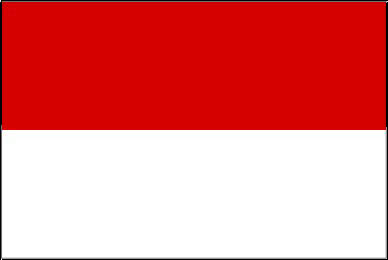
latest picture: January 2, 2007
- click a picture to see details
|
More websites from
Borneo – before we arrived in Indonesia – and when we returned in 2010:
|
-
- On November 21st, 2006, we left the Island of Borneo
after half a year, where we overhauled completely
our car and visited the Malaysian provinces of Sarawak
and Sabah and two new countries – Brunei (# 154) and in Kalimantan the "begin" of
Indonesia (# 155) –, driving a total of 3'258 miles. Two days later, we arrived on a
domestic ferry in Jakarta, the capital of Indonesia, a mega-city of about 17 million
people on the island of Java. Then, a whole range of more Indonesian islands followed:
Sumatra to the West and Bali, Lombok, Sumbawa, Rinca with the Komodo Dragons, Flores,
Sumba and Timor to the East. In-between we explored the 156th country – Timor-Leste –, before our Indonesian roundtrip continued
in Sulawesi and ended finally in Kalimantan on the Island of Borneo.
|
-
-
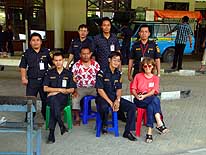
|
-
-
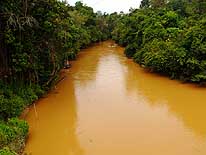
|
-
-
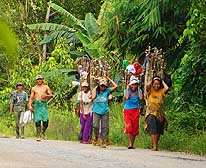
|
- 49
(Kalimantan) Liliana has a friendly
- chat with the welcoming Indonesian
- Customs officers at the Entikong Border
- Crossing, while Emil is finalizing the paper
- work of the car. The entry procedure
- took 45 minutes and was very easy
|
- 50 (Kalimantan)
Jungle rivers always
- are surrounded with a kind of
- mystery, here between Ngabang
- and Sosok in the province
- of West Kalimantan
|
- 51
(Kalimantan) Despite the
heavy
- load on their backs, these people smile
- towards us. Indonesians are a happy folk
|
-
- The stories about widespread corruption of Indonesian customs officers, policemen and
officials do not stop reaching us. No wonder that on November 18th, 2006, we approach the
border town of Entikong and the first military checkpoint with some mixed feelings.
Immediately, a friendly face appears at Emil’s window only asking him –
benevolently smiling – to register in a big book. Right afterwards, the immigration
officer greets us with “Welcome to Kalimantan”
and stamps our passports without delay. In the meantime, the customs people have spotted
us too and wave us to their side with the same friendliness. Having expected corruption at
any time, we are by now somehow confused: “May be it starts now”! Emil gets off
the LandCruiser and presents our car papers to the responsible person – the
“Carnet de Passages” (the car customs document) and our permit to drive with our
own car in Indonesia. (This most important permit – although we did have to show it
just once during our eight months journey, only when arriving by ferry on the island of
Sumba – was issued by Interpol Jakarta after many months of time-consuming
bureaucracy, and was sent to the Indonesian Consulate in Kuching in Sarawak on the island of Borneo,
where we could collect it against a small fee). Emil is then guided to the big boss.
Meanwhile, the officers offer me a chair and invite me to join them. One of them speaks
good English and acts as a translator. “What part of Indonesia are you planning to
visit?” This is of most interest to all of them. When I start to mention some of
their 17’000 islands: Java, Sumatra, Bali, Lombok, Sumbawa, Flores, Sumba, Timor and Sulawesi,
they flash proudly. In less than a quarter of an hour, Emil returns in company with the
boss in order to make the routine check of the engine and chassis numbers of our
LandCruiser. When – as usual – we automatically open all the doors for
inspection, some more curious eyes are gathering. But it is obvious that they all are more
than reluctant to touch anything of our camping equipment. They just look with
astonishment. Of special interest to them is our 12-volt Engel refrigerator. That was it!
Nobody wants to be bribed, everything went the correct way. In less than 45 minutes, the
entry procedures are completed. There are all over smiles and waves when we drive off.
What a promising welcome into Indonesia!
|
-
-
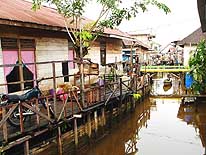
|
-
-
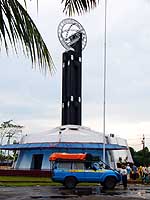
|
-
-
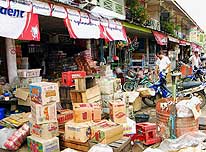
|
- 52 (Kalimantan) In Pontianak –
- situated right on the equator –
- life on the river banks is colorful
|
- 53 (Kalimantan)
In Pontianak in
- Kalimantan we cross once more – for
- the 29th time – the Equator – here
- during rainy weather from North to South
|
- 54
(Kalimantan) Each space
is taken:
- Chaos on Indonesians crowded streets
|
-
- Happily, we drive our first miles on a narrow, over and over repaired street in our
155th country. At first, we don’t observe any remarkable difference to the Malaysian
part of Borneo, but little by little the greater poverty becomes apparent. We see people
washing themselves in the river and carrying heavy loads on their heads: Containers with
water, sacks of wood and baskets with all kind of goods. Ducks, chicken and goats are also
roaming on the road. They scurry headlessly when we drive past. Everywhere people greet us
with warm and open smiles. A young mother seizes my arm through the open window when we
slow down at a street corner and sends a kiss on the hand after me. What a lovely gesture!
When we approach Pontianak, the capital of Kalimantan, it’s pouring heavily with
rain. The town is lying on the equator and its monument is right on our way into the city.
“How many times did we cross the equator up to now?” I ask Emil. He doesn’t
have to reflect for long and starts to count all the places by heart: Brazil, Ecuador,
Gabon, Congo, Uganda, Kenya ....... I count with him: This is our 29th time. Pontianak has
a reputation to be a city of industry, prostitution and crime. The latter one is one of
the reasons why we take “refuge” in the Hotel Khatalistiwa, where there is a
safe parking lot for our LandCruiser too, which is even more important than our room. It
seems that we have to get used again to Indian-like bathrooms with bucket showers, what
Emil isn’t at all enthusiastic about. It consists of a big, irremovable container,
filled with water (how fresh might it be?) and a scoop to pour water over the body. The
water tap to refill is above the container, making it impossible to wash the hands under
the running water without “contaminating” the shower water. But on our long
journey, we learnt to improvise. We fetch our own hose and pull it over the tap, and ready
is our preferred shower! Next morning, we start with the investigations about ferries
connecting other islands. Our wish number one is to sail first to Sumatra, thus being able
to cross the many Islands from West to East. At Pelni Lines, we get two no’s: We
learn that there are no car ferries between Pontianak and Sumatra, and Pelni doesn’t
transport cars anyway, only passengers. At least, we get referred to the Prima Vista
Shipping Company. There, we are welcomed with the already well experienced friendliness.
|
-
-
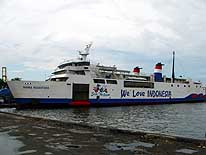
|
-
-
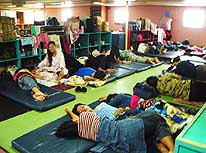
|
-
-
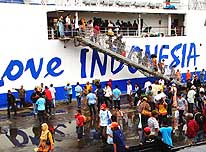
|
- 01 This Indonesian ferry was our
- “home” for 38 hours from
- Pontianak/Kalimantan on the island
- of Borneo to Jakarta
|
- 02 Who cannot afford a bunk
- bed – called "cabin" –
- sleeps on mats on the floor
|
- 03 Arrival in Jakarta: Everybody
- is happy to have reached
- their destination safely
|
-
- Immediately, we are informed that our only possibility is to ship to Java the main
island, either to Jakarta, Semarang or Surabaya, and that the next car ferry to the
Tanjung Priok – the ferry port of Jakarta – is sailing tomorrow night at 11pm,
for a price of 3.5 Mio.Rp (= approx. US$350) for our LandCruiser, plus 20’000Rp
(US$2) for the driver and 185’000Rp (US$18.50) for the passenger. Because we
don’t know whether a third part insurance is compulsory in Indonesia, we do not want
to take any risk and try to find an insurance company. Our third approach is fruitful: JP
Astir/JP Jasarahorja Putera is issuing one for 450’000Rp (US$45) for a period of
three months. It takes quite a while until the paper is ready, but in the meantime, we are
looked after very well, with cold drinks and exotic fruits from Bali – another
testimony of the great hospitality of this happy and friendly people. At 10pm on the
departure day, hundreds of passengers with bags and baggage climb the gangway to the
ferry. With no much light around, it’s a real chaos: people running into the ship,
coming out again – nobody seems to know who is a passenger. While Emil waits to be
directed on board of the ferry, I decide to inspect our booked cabin. A young crew member
brings me into a huge dormitory with bunk beds – later, we count 84! – where
most of them are already taken. He points to two still empty ones near a wall, which
numbers seem to correspond with the ones mentioned on our ticket. First I think that he
made a mistake and repeat the word “cabin” again explicitly. But as he continues
to nod energetically and pointing again at the same direction, I finally realize that
these two beds will be our “cabin” for the next two nights. Probably, the
disappointment is written on my face, because a smart officer standing nearby
spontaneously offers us his personal place. “How much do you want for it”, I
ask. “300’000Rp (US$30) is his straight forward answer. When we see the smelly,
tiny cubicle and the unclean shared bathrooms, we both agree: The dormitory is still the
far better choice. Besides us a woman of Chinese origin with her six years old son settles
down. Even in the middle of the night, she continues preparing bottles of milk for him.
Opposite lies a highly pregnant lady and the bed next to her is shared by different people
coming and going. As soon as the vessel starts sailing, everybody is directed to its
assigned place and then, all of a sudden the crew is checking the tickets and searching
for stowaways.
|
-
-
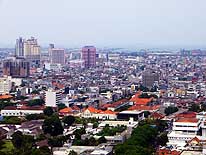
|
-
-
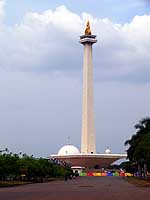
|
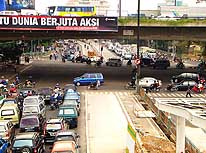
|
- 04 We enjoy a relatively clear
view
- over usually very smoggy Jakarta
- from the top of the National
- Monument on Merdeka Square
|
- 05 Monas, the National Monument
- on Merdeka Square, is 450ft. high
- and Jakarta’s principal landmark,
- built by Sukarno as a symbol of
- Indonesia's independence and strength
|
- 06 Jakarta’s streets are
hopelessly
- congested on all levels at all times
- of the day; accordingly, also
- the air quality is precarious
|
-
- Besides much talking and laughing around the clock, the loud announcements through the
loudspeakers of which content we have no clue, and the various calls for prayer – the
first one as early as 4am – (Indonesia is the biggest Moslem country in the world),
life on board is surprisingly orderly. Morning, noon and evening simple meals are served
in white Styrofoam boxes to the bunk bed. More or less it is always the same: Plain
steamed rice, some vegetable and a tiny piece of egg or a kind of indefinable meat and a
plastic cup of mineral water. In the lower class, life is considerably less comfortable.
There are too many people lying side by side on the floor, squeezed between their
luggages. Some could rent mattresses. Luckily, the sea is relatively calm. But when the
swell gets occasionally stronger, it gets very quiet in the dormitory. Then we hear
vomiting. One woman is very sick for hours. Apart from sea sickness, she is badly
shivering ceaselessly. We offer her some tables, which unfortunately do not help. It could
well be that she has contracted Dengue or Malaria. It does not look too good for her. Now
and then, Emil visits our LandCruiser down in the hull which is squeezed unlashed between
equally unsecured fully loaded trucks. One time, he returns very upset: “You will not
believe it”, he tells me. “Nobody is down there and the sea water is entering
through the open side doors. Under our car, already two inches of water is flowing. I
closed the two doors as good as I could, because from the four iron bars three are
missing.” Who is to be blamed? Our guess is that it is too hot for the truck drivers
who sleep in their cars to save money. Thus they open the small side doors, being less
than one meter above sea level, to get some fresh air in and do not care afterwards about
it any more. And the crew does not supervise it anyway. As long as the sea is calm, there
is no problem, but there is one definitely by strong swell – and if it rises
it’s too late. No wonder that so many ferry disasters occur in Indonesian waters!
(Only 1½ months later the sister ship drowned with about 600 fatalities; it is assumed
that the same doors were left open during rough seas).
|
-
-
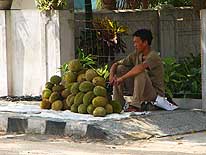
|
-
-
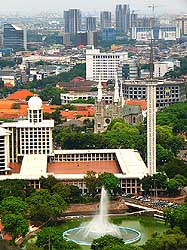
|
-
-
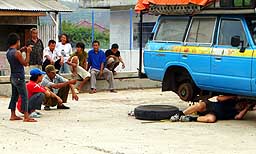
|
- 07 At a street corner, a Durian
vendor
- is waiting patiently for customers.
- Contrary to the similar looking
- jackfruit, the Durian fruit is spiny
|
- 08 An attractive view to the
Istiqlal
- Mosque and the Cathedral between
- Jakarta's houses and skyscrapers,
- photographed from the
- Monas Monument
|
- 09 After only 52 miles on
Sumatra’s roads,
- our journey ends on this island already in
- Bandarlampung with a broken rear
- differential. Emil disconnects the drive
- shaft, giving us the possibility to return
- very slowly to Jakarta for repair
|
-
- After 38 hours of sea journey, Jakarta’s skyline is greeting. It is 2pm when we
drive with a delay of three hours from the hot hull on to the breezy pier in Tanjung
Priok. “How will the harbor police react to our LandCruiser?” And once more we
are surprised. The gate is open and instead of interrogating us, the police officer on
duty smiles from cheek to cheek and helpfully gives us directions how to exit the port.
Luck seems to be still with us, we happily think. But shortly after, it abandons us a
little bit. Not having an accurate map of this mega-city, we first get desperately lost.
And when we finally find the area where most of the budget hotels are located, the
receptionists all say the same: “Sorry, we are full!” It is getting dusk and we
are quite worried. Finally, we end up at the Sofyan Hotel with own guarded parking. The
room is not cheap, but we take it anyway after our long and tiring sea journey. And a hot
shower, a gin tonic and some bread with cheese later, we already fall asleep. A long time
has passed since we last saw Claude, our Consul. It was in 1999 in Abu Dhabi in the United
Arab Emirates. We met him first in 1992 in Kuala Lumpur in Malaysia, when he was posted
there. The day after our arrival in Jakarta, we pay him a visit at the Swiss Embassy. The
joy to see each other again is on both sides. This time, we owe him a lot and want to
thank him for being involved personally to get the complicated car paper to enter
Indonesia done. Jakarta is, however, not a city where we wish to stay long.
Overpopulation, pollution and traffic jams with no limits are the most striking realities.
There is no proper pedestrian area to explore on foot, but merely congested centers apart
from each other. Where is the quality of life, we ask ourselves, when we are continuously
stuck in traffic jams and the black smoke of the trucks and buses makes us choke, or when
we need alone three hours from one part of the city to the other, as it happens when we
are invited to a lunch to the Novotel by Raetus, the Swiss Manager. (This time it was well
worth it: The steak was delicious and tender, and the spinach alone was a delicacy).
Nevertheless, we do not want to miss the only real tourist attraction, the 433ft. tall
Monas National Monument, towering over Merdeka Square – Jakarta’s principle
landmark. It was built by General Suharto – who came to power after a coup in 1965
and was ousted 1998 – as a symbol of Indonesia’s independence and strength. Its
struggle for independence is displayed in the National Museum in the basement of the
monument in four dozens impressive dioramas. And for once, the skies do not hide entirely
behind a cloud of smoke and – from the monument’s top – we can enjoy the
view over 20 miles of the sprawling city.
|
-
-
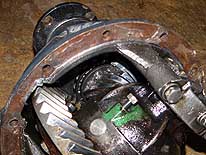
|
-
-
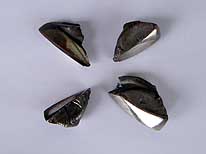
|
-
-
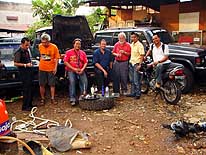
|
- 10 The third damaged pinion
after
- 129’464 miles. Harry Sanusi sells us
- two used differentials of his FJ40
- and replaces them in his workshop
|
- 11 Corpus delicti:
- The four broken-off teeth
- of the pinion
|
- 12 Refreshments after successful
repair
- and interview for the TV news at Harry’s
- workshop. From left: TV moderator of
- Indosiar TV channel, Harry Sanusi, Dito (JIP-
- Magazine 4x4-Reporter), Harry’s brother
- Bibib, Emil, Harry’s son Reza and a friend
|
-
- Two days later, we are the last vehicle to board the ferry at the Merak terminal in the
West of Java leaving for Sumatra and get a privileged place beside the ramp in the fresh
air. A few sportive youngsters are diving around the boat for coins that passengers drop
into the water. It is 3.30pm when the ship sets out and we enjoy our delayed lunch from
our own kitchen: Sausages from the Hero Supermarket, boiled eggs, salad and cheese, while
we sail peacefully towards new land. It’s already night when we arrive at 6pm. But we
are not keen to spend the night in the crowded small port of Bakauheni. Instead, we are
eager to reach Kalianda, 20 miles to the North. Luckily, the same named hotel with own
parking can offer us its last AC room. After a good nights sleep, we continue fully
motivated towards Central Sumatra. But with each mile we drive, being forced to crawl with
a 6 mile speed per hour behind a steady stream of diesel-powered trucks, discharging a
thick black smoke that assaults our senses and hardly having any opportunity to overtake,
our enthusiasm fades away. At some point our mood hits rock bottom and Emil blows his top.
“If it continues like this, I turn around”, he exclaims, and I know that he
really means it. “There are still 2’500 miles to go from here to Medan and back.
Why should we go through all this hassle and suffer” he continues. Right he is, I
think, despite that I have been really looking forward to explore this island. Shortly
after Bandar Lampung however, our LandCruiser decides itself. From the rear we hear an
alarming rumbling. “It must be something serious”, Emil immediately worries.
“I just do not know what. It can be the gearbox, the axle, the clutch or even the
differential”. We manage to find one of the rare flat spots on the side of the road,
where Emil starts to take off the rear wheels in the first place. After a while, we know
it: It is the differential. Luckily, he is never short of ideas. He disconnects the
propeller shaft, puts it onto the car and in this amputated condition, we hope to finally
reach Jakarta again, where our chances to find spare parts are the best. Despite that the
noise is dramatic at each left turn and at each left slope, we reach at snail’s pace
Kalianda before dusk where we are able to sleep in the same hotel for another night. Next
day, we ferry back to Java. Our Sumatra journey has lasted merely 50 miles!
|
-
-
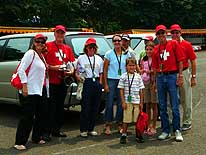
|
-
-
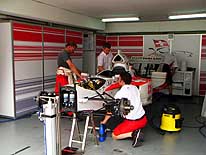
|
-
-
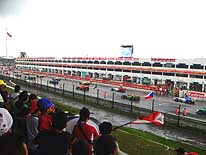
|
- 13 We attend the “Formula
A1-Grand Prix”
- car racing in Sentul/Bogor with a team of the
- Swiss Embassy – 37 miles South of Jakarta –
- which was founded by Dubai’s ruler Sheik
- Maktoum as a kind of competition to the “big”
- Formula-1 events; each participating country
- runs only one completely identical vehicle
|
- 14 The Swiss Team headed by Max
- Welti takes the last preparations at
- the pit stop. Driver Neel Jani
- placed Switzerland on rank 8
|
- 15 The race can start despite of
the rain.
- The 21 participants are in start position
|
-
- The first days back in the capital are frustrating. The main part is not available at
Indonesia’s Toyota Astra. It would have to be ordered in Japan what takes at least
two months, we are told. In our dismay, we are looking for alternatives and soon take into
consideration that Emil returns to Sarawak in East-Malaysia, where our car is quite
common, to organize the needed parts himself. Unexpectedly, a lucky chance pops up, when
we are invited to attend the Swiss Fondue Dinner at the Aryaduta Hotel next evening.
There, we meet “Karman” – as he calls himself – a guy from the press
accompanying the Swiss Formula A1 Grand Prix Team with Max Welti as its leader. When we
touch our differential problem, he is eager to help us and starts to phone around. That is
how we end up at Harry Sanusi’s place. Harry is an Indonesian passionate 4x4
enthusiast. He wants to modify his FJ40/1982 LandCruiser and is willing to sell us its
differentials – both for Rp 4.5 Mio (US$450). Happily, we agree. During the next
three days, our LandCruiser is being repaired at Indonesian pace by his mechanic in his
small place overloaded with vehicles. But time is on our side, and we are looked after
very well by Harry and his son Reza. In their distinguished Restaurant, built in Japanese
style, we sample lovely Indonesian food – Sate with peanut sauce and Nasi Sirloin
being our favorite ones – and love to listen to their adventurous stories of their
trips throughout Asia with their 4x4 club. Can we therefore say “no” when they
would like to organize some press coverage? First to arrive is Dito, a free lance
journalist writing for the 4x4 magazines JIP and Top Gear Indonesia, and later Indosiar
and Global TV. As a special gesture and because he wants to follow our journey to the
East, Dito convinces Telkomsel to sponsor us a cellular phone each – they become our
first ones. It is really amazing: We have now been traveling for 22 years without such a
mean of communication, but in the shortest of time, we get so used to it that we do not
want to miss it anymore. Especially, it becomes indispensable when it comes to ferry
schedules. Because it can easily happen that we get three different sailing dates for the
same destination. Therefore we need to keep us informed by rechecking, double checking and
rechecking again.
|
-
-
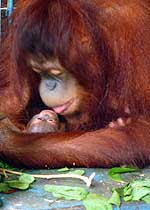
|
-
-
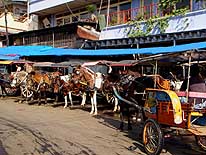
|
-
-
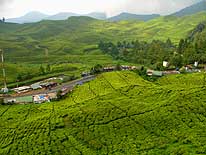
|
- 16 An Orang Utan mother cares
lovingly
- for her three-week old baby in the
- rehabilitation center “Pusat Primata
- Schmutzer” in Jakarta’s Ragunan-Zoo,
- lead by Ulrike Freifrau von Mengden
|
- 17 Nostalgic horse-drawn carts
are
- still very popular as a mean of transport
- in Indonesian cities. Also in the center
- of Cipanas they wait for customers
|
- 18 In the cool mountains of West
Java
- lush tea plantations offer beautiful scenery.
- This spectacular sight is from the viewing
- area of the 5’000ft. high Puncak-Pass
- between Bogor and Bandung
|
-
- Already at our Swiss dinner, we are invited to the Formula A1-Grand Prix car race on
December 10th, in Sentul near Bogor, 37 miles South of Jakarta. It has been founded by
Sheik Maktoum from Dubai as a kind of competition to the “world-famous”
Formula-1 events. The special feature here is that all participating countries will
compete with an identical car – though all have the same chance. We join Claude, our
consul, and other embassy staff and their families to the racing field and to begin with,
have an interesting look into the box of our team, where preparations are still being
made. Meanwhile, already a big crowd has gathered at the stands, but we still get good
seats. The very moment the 21 participants are in their start position, a heavy downpour
brings everything to a standstill. But 20 minutes later, the race opens. Even more
exciting than the competition itself are the tire changes at the various boxes. We check
the time: 12 seconds are best time, simply incredible! Our driver, Neel Jani, achieves
place No. 8 for Switzerland. Apparently, the injection fuel pump was the reason that he
lost speed in the first round. The winner in the 70 minutes lasting contest over 15 rounds
was New Zealand, followed by Germany and France.
|
-
-
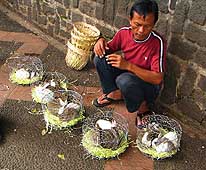
|
-
-
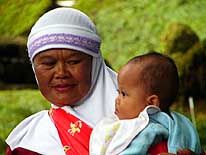
|
-
-

|
- 19 A street
vendor in Bogor is
- selling young rabbits at the road side
|
- 20 A
grandmother is looking
- caringly at her grandchild
|
- 21 Cupolas of
mosques are eye
- catching everywhere, also in the
- poorest neighborhood of Bogor
|
-
- On a Saturday, we find ourselves for the third time – after Sabah and Sarawak
on the island of Borneo – face to face with the
lovable – human-like Orang Utan at the Rehabilitation Center “Pusat Primata
Schmutzer”. It is attached to Jakarta’s zoo and was founded by Baroness Ulrike
von Mengden from Germany. This time, our encounter is somehow different: These animals are
normally caged, except at visiting hours, when the youngsters are free to roam around and
make new friends with humans. They love to be taken by the hand for a walk, play around
and hug. They are of gentle nature and tame, but in a way also persistent to get what they
want. A female is totally focused on Emil and has chosen him as her play mate. He really
enjoys it for a while, but the young lady is very persistent and does not let him out of
her grip. At some point, enough is enough! They are very strong creatures, apparently
seven times stronger than humans, can grow to 5 ft. tall and weigh 440 pounds. I can
confirm their strength! One moment, I stepped too close to one of the cages and before I
am aware of it, the animal grabs my leg and tries to pull it through the narrow lattice. I
cry for help. A warden and Emil come rushing simultaneously. But even being two strong
men, they need a lot of force to free me. How subtle, however, they can be on the other
hand, we experience when we feed them peanuts. It is amazing to observe how these wild
creatures grab them very softly with their lower lip, then crush them gently and finally
spit out the husk. Nothing is greedy about it. Touching and very sweet is mother Amida
with her three weeks old daughter Mio. She rocks her baby lovingly in her arms, hugs and
cuddles it heartily. Now and then, she holds her up with both arms – her behavior is
exactly the same as a loving human mother would be with her child. Baroness Ulrike von
Mengden, now 85 years old, tells us with sadness and worries that the continuation of her
50 years life-work, for which she gave all her heart beats, is in real danger. The
Indonesian Government does not support her, and there are serious financial problems too.
Despite that she has some difficulties walking momentarily, she guides us to the cages
with the 40 to 50 years old primates. It hurts watching them pressing their faces to the
grills and looking at us with sad (and accusing?) eyes. They are waiting for too long
already to be released into their natural habitat, into the jungle of Kalimantan. But
there is no money for their transport. Where are all the aid organizations? Our small
contribution helps merely to buy some food. We wish we could do much more for them!
|
-
-
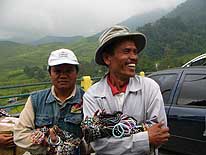
|
-
-
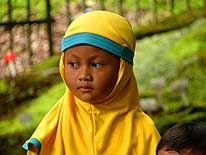
|
-
-
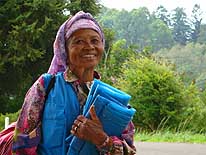
|
- 22 The nice
smile of this souvenir seller
- on Puncak-Pass is the symbol of the special
- friendliness of the Indonesian people. Even
- the police acts the same welcoming way.
- We are just happy to be here
|
- 23 87% of the
Indonesian population
- is Moslem. Girls wear the traditional
- head scarf already in their young age
|
- 24 We meet
this happy face in the
- Botanical Garden “Kebun Raya
- Cibodas” in Cibodas, where she
- sells blue tarps for picnics
|
-
- On December 18, it is time to move on, to say good-bye to the mega-city of Jakarta. We
take the turn to Bogar, another congested place, also called “rain city” by the
locals because of the most days per year with thunder. Here, especially the small green
city busses are to be blamed for the incredible chaos, because they stop anywhere at
anytime to let in or let out passengers. Squeezed in between are the omnipotent
motorbikes, nostalgic horse drawn charts, bicycles, rickshaws and merchants who also want
to cross the road with their push carts. Just the cows are missing; otherwise we would
think to be in India. I really enjoy this crazy atmosphere, not so Emil though, who has to
fully concentrate on the confusing traffic. The heart of Bogor is its Botanical Garden
“Kebun Raya”, covering an area of around 200 acres with herds of white spotted
deer roaming on immaculate lawns. Its alleys are dotted with old trees, ponds with lotus
flowers, forests of palm trees and an orchid garden. For a small entrance fee, we can even
roam around with our own car and enjoy this oasis of calm. Next morning, we finally climb
towards the mountains, to the Puncak Pass. Hotels, restaurants and eateries form a never
ending line on both sides of the road. Only when we reach the pass on 4’920 ft.
altitude, we can breathe some fresh air and enjoy the first stunning view over the immense
tea plantations surrounding us. The frightening effect of a relentless population growth
is visible also in the mountains. To find a secluded place to set up camp – or even
just to have lunch – is like winning the first price in lotto. Therefore, we keep our
eyes open for a reasonable hotel and book into the Bali Ubad Guesthouse in Cibodas. The
unusual hobby of the lady owner, who is not willing to reduce the price of the room, is
her male goats. She owns a couple of these great guys with names like Benito Mussolini and
Adolf Hitler, one of them being already a multiple champion in goat fighting. They are
kept in separate small cages, but need to compete with equally strong opponents once a
fortnight, she tells us. Some dogs and also a monkey belong to her menagerie, but they
have to live in pitiful small cages too.
|
-
-
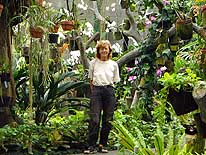
|
-
-
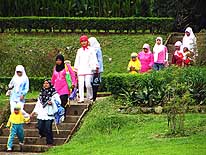
|
-
-
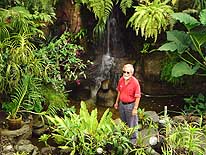
|
- 25 Liliana is
posing for a picture in
- the middle of the lovely orchid house
- at Bogor’s Botanical Garden .....
|
- 26 .....
Mothers and children visit the
- Botanical Garden in Cibodas .....
|
- 27 ..... and
Emil enjoys a moment
- in a wonderful surrounding in
- Bogor’s Botanical Garden
|
-
- We are the only guests. From our veranda we have a lovely view over a lot of greenery,
over araucarias and banana trees, blooming tropical flowers and the perfectly formed
twin-volcanoes Gudung Gede and Gudung Pangrango that reveal themselves in full beauty in
the evening hours. When, next day, we make our way to the Kebun Raya Cibodas Botanical
Garden on a narrow dirt road, they are covered in fine mist. We pass many plant nurseries
lining the path, not normal ones, but very exceptional ones, real arts in the way they
arrange their different plants. We cannot drive past without stopping and admiring the
attractive patterns. First we thought that it is a professionally planted garden, until we
realize that all are potted plants. But this is only the introduction of what we find at
the Botanical Garden on the slopes of a dense tropical jungle: A charming alley of ancient
araucaria trees, the oldest one dating back as far as 1866, all kind of splendid palm
trees, magnolia with its subtle fragrance and an array of richly flowering tropical
plants. Hungry, but not yet ready to leave this Garden of Eden, we improvise a simple meal
– Pop Mie, tuna fish and cheese. Only late afternoon, we return to our guesthouse, to
Mussolini and Hitler (what a choice of names!). The next day paddy fields spread out along
the road, as we move on to the East. As it was in Vietnam, no inch of soil gets wasted.
Wealthier farmers have machines or water buffaloes doing the hard work, the poorer ones
drag their large rake by hand through knee deep water. Villages with red tiled roofs now
and then interrupt the green of the fields. In Bandung, another Indonesian mega-town, we
take actually the short cut, but soon after are tempted by the sign “Carrefour 5
minutes” to exit the highway. We urgently need to stock up our beverage supplies and
also would like to eat a bite. Ahead, we run into a big scale police traffic control. But
again, we are waved through with big smiles. So far, we have not experienced the slightest
sign of corruption yet. After good shopping and a less good pizza in Pizza Hut, which did
not keep what it promised, the highway has us back. Through beautiful scenery, we reach
Cipanas on the outskirt of the town of Garut, where we decide to stop for the day.
|
-
-
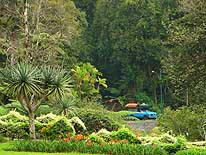
|
-
-
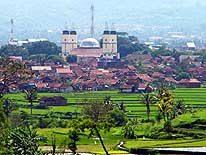
|
-
-
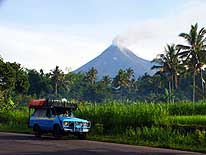
|
- 28 Our
LandCruiser is surrounded by
- beautiful species of old trees and plants
- in the botanical gardens of “Kebun Raya
- Cibodas”. Some trees date back to 1860
|
- 29 In the
valleys of Java, lush green
- paddy fields are everywhere. Also here
- in Garut they spread to the doorsteps
- of the city and contrast wonderfully with
- the red brick roofs of the houses
|
- 30 9'590 ft.
high Gunung Merapi is
- cloudless and smoking when we
- drive from Yogyakarta towards
- the mountain resort of Kaliurang
- at 6am
|
-
- The small resort is beautifully surrounded by carpets of lush rice fields and framed by
smoking volcanoes – a captivating sight. And there are the promising thermal wells!
We check into the Tirta Merta Hotel. The room with its decorative walls of woven palm
leaves is small, but cozy. But what hits us the most is the big sized bathtub, with hot
water piped in continuously from the hot springs around the clock. We enjoy our private
thermal bath so immensely, that we extend our stay another day, then another one until a
noisy family moves in as a neighbor. Many of the local guests are already washing their
cars (with hot water) when we wake up. In a way we cannot help thinking that they do
exactly the same thing here as they would do at home. When we want to take breakfast, we
find our bred full of holes – it looks like an Emmental cheese. Now we know that it
was a mouse that woke us up in the middle of the night with its mumbling in our bread bag.
But it is not a problem, in the hotel shop, we easily can get a replacement. Passing tea
plantations and more carpets of rice on a scenic drive, we leave the freshness of the
mountain region and dive into the hotter and monotonous plains. And, as it has been the
last few days, it starts to pour down and does not want to end even on this special day of
December 24th – Christmas Eve. We therefore take a room in the Hotel Borobudur in
Majenang already early in the day and sip the hot welcome tea on our veranda, which is
common in Indonesia. Nothing reminds us that Christmas is celebrated around the world in
this deeply Moslem state. Only next morning, when we switch on our small hotel TV, we
experience some Christmas spirit in tropical Central Java: The mass from the Vatican is
broadcasted and a ladies choir sings contemplative Christmas songs. Jakarta shows a
different picture though: In front of the cathedral, the bags of worth shippers are
searched thoroughly and the police is checking the cars – there is a fear of an
imminent terrorist attack!
|
| 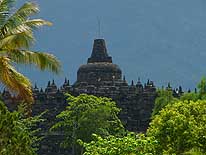
|
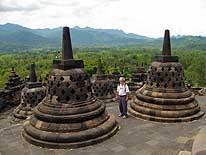
|
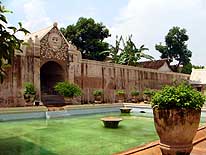
|
- 31 The
delicately sculptured Buddhist
- temple of Borobudur – a UNESCO
- World Heritage Site – was hidden under
- layers of volcanic ashes until 1815 when
- it was cleared by Sir Thomas Stamford
- Raffles and later restored by the Dutch
|
- 32 In each of
the bell-shaped Stupas,
- which surround the main pagoda,
- sits a partly visible Buddha statue
|
- 33 Taman Sari,
the Water Castle in
- Yogyakarta, was once a splendid
- pleasure park of palaces and pools
- for the Sultan and his family
|
-
- The rest of the day, we are hunted by bad luck: Rain continues to fall, the promising
Fuji shaped volcano in the hill resort of Baturaden is hiding persistently behind a wall
of clouds, and all attempts to eat some decent food in a restaurant or eatery along the
way fails due to either a uniform menu or lack of hygiene. And who wants to swallow some
cold food in the car along a busy road on a Christmas day? Therefore we continue with an
empty stomach until Wonosobo, situated on an altitude of 2’950 ft. and try our luck
at the Asia Restaurant, recommended by Lonely Planet. Emil orders “Cheese Roti”
(of course it has to be something with cheese!) and me Nasi Vegetarian. When we are served
and I look at Emil’s plate, I feel really sorry for him – particularly on
Christmas Day. It is just a plain toasted cheese sandwich, without any trimming at all
– it does not really help much to raise a festive spirit. Still, there is a Christmas
surprise waiting for us in the evening. Our friend Marco from Switzerland calls us to our
new handy from home. Merry Christmas! On 8am, we are on the road again. Volcanoes greet us
in their immaculate beauty when we leave for Borobudur’s ancient temple and
Indonesian’s most famous tourist attraction. This UNESCO world heritage site, built
1200 years ago in the form of a massive Stupa gracing an entire hill, is a Buddhist
temple. Through countless stalls selling hats, postcards, cold drinks, umbrellas and
souvenirs, we plough our way to the gate to pay our entrance fee and are not surprised
that, as foreigners, it is ten times higher than for locals. But this is quickly forgotten
when we are standing in front of it, flanked by flowering gardens, rice fields, palm trees
and an imposing mountain scenery. As we walk along the different terraces, we soon begin
to sense the atmosphere of this ancient civilization. We admire the treasures – the
beautifully carved Buddha statues sitting in niches and the innumerous richly decorated
relief’s, depicting scenes of Javanese life – from royal to war, from elephant
to musician processions.
|
| 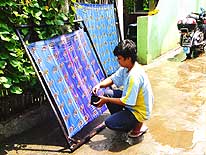
|
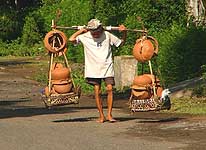
|
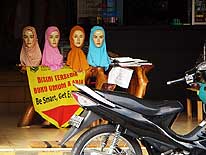
|
- 34 In
Yogyakarta's narrow alleys
- beautiful batik is produced .....
|
- 35 ..... a
pottery vendor
- is on the move .....
|
- 36 ..... and
head scarves for women are on
- display on this predominantly Islamic Island
|
-
- This cultural heritage has been lying under deep covers of volcanic ashes. Only1815,
when Sir Thomas Stamford Raffles reined Java, it was set free and later restored by the
Dutch. Our favorite place is the top, at the foot of the central Stupa, flanked by clock
shaped smaller ones, each housing a Buddha statue, partly visible through the lattice
work. This “Buddhist monastery on the hill”, how it is also called, was built
from two million blocks of stones, which we are exploring under the blazing midday sun
with the advantage that due to the heat – we are alone. Only two hours later, when we
leave, the crowds start to flock in again. Despite all the beauty, we are still a little
bit disappointed, as we expected to find something similar to the grandeur of Angkor Wat
in Cambodia. But what we saw was just one single temple.
Only when next day we discover two additional small Buddhist treasures on the outskirts of
Borobudur, we revise our opinion somehow. Both are small, but equally beautiful – the
tiny Candi Pawon as well as the Mendut temple that in its central niche houses a three
meter high Buddha said to be in its original setting and also special in that way that
instead of sitting in lotus position, he sits Western style with both feet on the ground.
But over all, we admire the wonderful relief panels, especially on the outer walls. Right
before Yogyakarta, we still are not sure whether we shall take the bye pass. We are fed up
with all the pollution and the chaos of the Indonesian mega-cities. But again, there is
this inner voice: ”Are we possibly missing something?” That is the reason why on
the intersection, we follow the sign to the Kraton, the ancient walled city that once
housed 25’000 people. However, to find the right way through the confusing one way
system that made us headaches also in other towns is all but easy. When Emil spots two
overland buses with Jakarta license plates in front of us, with his enviable logical
thinking he is sure that they are driving also to the Sultans Palace. “Where else
would they go”, he explains. We follow them and really find ourselves shortly after
in the heart of the old city.
|
| 
|
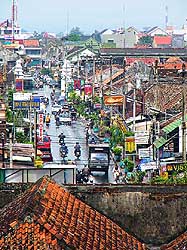
|
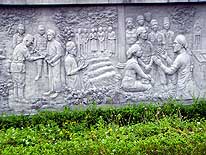
|
- 37 The
reception hall of the Sultan Palace in
- Yogyakarta – also called "Golden Pavilion" –
- is the main attraction of the ‘Kraton’, the once
- walled city, where 25’000 people lived
|
- 38 View over
one of the
- lively roads of Yogyakarta
|
- 39 One of the
many impressive wall
- reliefs in the ‘Kraton’ of Yogyakarta
|
-
- Hordes of chatting and gesticulating youngsters climb from the buses and head straight
away to the main attraction – the richly decorated Reception Hall, called also
“Golden Pavilion”. Impressive is especially its intricately carved roof in red
and gold and the teak column bearing golden motifs. Until we find the Water Castle –
the pleasure park of palaces, gardens and pools for the sultan and his harem – we
probably get to know all the narrow cobble stone alleys of the old city dotted with batik
galleries. As we seem to be lost, we ask an elderly lady for directions. She points to a
narrow path right in front of us. This is how we end up at the back door of the castle.
Walking through this lovely park, it is not difficult to imagine what life was at that
time behind the hiding high walls. Legend has it that the sultan had the architect –
a Portuguese – executed after completion, to keep his pleasure park secret. When we
are heading back to the parking lot, we pass another historic place that we did not intend
to visit. Suddenly, there is a dispute between a guard and Emil when he gruffly asks for a
ticket, and Emil replies equally gruffly. The following words fall:
Guard: I hate tourists
Emil: Then, you have chosen the right job.
He shows Emil middle finger up. After all the great friendliness we encountered, we are
quite shocked about this disturbing incidence, but we also know that we are coming closer
to the cradle of Islamic fundamentalism. Solo is the native town of Abu Bakar
Ba’asyr, the leader of Jemaah Islamiah. He was accused of having initiated the Bali
and Marriott bombings, was imprisoned, but later set free. Luckily, this is a single case
of individual aggression. Nevertheless, we are not anymore in a mood to visit Solo. We
just make a brief stop at an internet cafe to load down some emails, what – like in
many other places – takes ages.
|
| 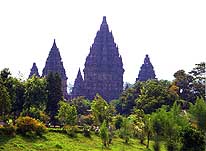
|
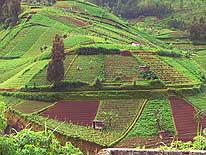
|
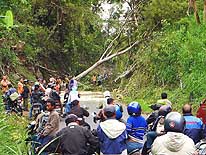
|
- 40 Prambanan,
situated 11 miles
- East of Yogyakarta, has the
- biggest Hindu temple in Indonesia
|
- 41 The
terraced rice fields stretch up
- to the steepest mountain slopes of 10’705ft.
- high Gunung Lawu, here at Tawangmangu
- between Solo (Surakarta) and Madiun
|
- 42 The many
scooters wait patiently
- until a fallen tree is removed on the
- mountain road between Kediri and Batu
- south of the 11’148ft. high Gunung Arjuna
|
-
- “Where are you heading next?” the owner asks suddenly. “To
Karanganyar-Tawangmangu-Sarangan, along the Lawu volcano”, we mention. “You
really want to try this extremely steep road with this car?” he says in disbelief. It
is not very encouraging. After the crowded and polluted main road, the freshness of the
mountains is a real gift. Soon we find out that we are in a touristy region. Saddled
horses are offered to hire around each corner. Then, with some rumors in the stomach,
after Tawangmangu, we reach the ill-famed “vertical road” climbing skywards.
Will we make it? Engaging four wheel drive, we start slowly but steadily to crawl uphill,
past two stuck vehicles with open steaming bonnets, just hoping deeply that we will not be
forced to stop the same way. Because then, we would have a real problem to restart. But
our LandCruiser makes it with its own power, causing us plenty of anxiety though. On the
top, we enjoy the views over the terraced fields, stretching up to the steepest of
mountain slopes. They look like a piece of art. After six hours of continuous driving, we
arrive at our today’s destination, the town of Batu before the city of Malang. There,
the skies start to release their wet freight once more and it does not stop raining
throughout the night. When we awake next day, the weather is unchanged. We are already on
the doorsteps of our wish dream, where we would like to spend New Year: Between the
grandiose volcanic scenery of Bromo National Park. In our thoughts we have pictured many
times how wonderful it will be to see the sun rise in the eerie silence of the volcanic
world on the first day of the New Year. Towards midday, we start our climb to Wonokitri,
lying on an altitude of 5’900 ft., said to be less crowded than the more popular
Cemoro Lawang approach. And indeed, we are the only visitors when we arrive late
afternoon, but also the only target for the many touts following us by motorbike. We try
to ignore them, but at the end, they are all under the same cover, and surely one of them
is cashing in on a commission, when we book a room in a small, family run guest house. It
is tiny and icy cold, but huddled in all our clothes and under all the blankets available,
we manage to go through the short night comfortably warm. At 4am our old alarm clock
shrills – the sunrise is waiting outside!
|
| 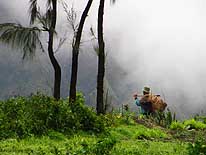
|
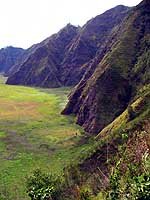
|
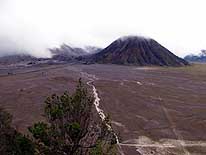
|
| 43 |
44 |
45 |
- A mystical atmosphere surrounds the volcanos of Bromo, Batok and Semeru on New
Year’s Eve.
- The mist disappears slowly a and reveals the beauty of the green “sand sea” in
the Tengger Caldera and the imposing volcanos
|
-
- But there is no sunrise today. The rain still continues pouring down and there is no
weather change in sight. We see our dream fade away; frustration is taking over. So we
decide to return to the plains. From last night’s storm, the narrow, windy road
downhill is covered with broken banana leaves and rust-red pine needles. All the way town
we feel depressed. Why not give it another try on the second approach of Cemoro Lawang?
Tomorrow, the weather might be fine – who knows. The mere thought of it raises our
spirits, and optimistically, we take the turn towards the mountains for the second time.
The landscape reveals itself to be very scenic and wild, and joyfully we climb up to an
altitude of 7’220 ft. Shortly before Cemoro Lawang, we arrive at the National Park
entrance gate. The cashier is so puzzled to see our car that he forgets to charge us a
ticket. Or is it hospitality? When we reach the top and the viewing area, we get a real
shock. Who said that we would be alone with our idea for a special New Years day? We never
expected to find such a crowd up here; we are not even able to find a parking spot. But
even more depressing is that all we can see at the viewing point is a hole covered in
thick mist. Additionally, a stiff wind is blowing, but our wind-jackets are stored in our
aluminum cases on the roof rack. And to go through all the hassle to get them down just
for a few hours, is not worthwhile, we decide. We rather prefer to shiver for a while what
is the reason for the attentive vendors to approach us, trying to sell us one of their
woolen hats. What is holding us up here any longer? When we discover a small road leading
to another valley, we follow it. But after a turn, where we still can see the mist
shrouded Mt. Batok, we decide to wait for a while along an onion field. To protect us from
the rain, wind and cold we remain seated in our car. Firstly, we enjoy our compulsory
“gin tonic”, followed by a portion of hot “pop mie” to warm us up. It
is amazing how such a simple meal can taste so deliciously!
|
| 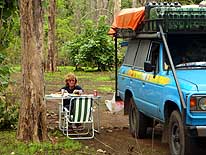
|
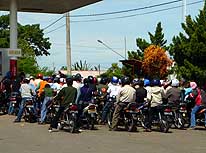
|
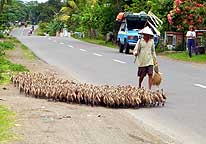
|
- 46 New
Year’s Day 2007: We find
- one of the very rare lonely spots in the
- Baluran National Park in Eastern Java
- where we are able to celebrate the
- New Year
|
- 47 Not only
Java’s roads are crowded
- with motorbikes but also the gasoline
- stations. Tens of thousands are on their
- way to the Pasirputih beach in Eastern
- Java on New Year’s Day
|
- 48 Also this
colony of little ducks
- wants once to cross the road
|
-
- And suddenly, the skies begin to clear, slowly though, but the view is wonderful. Below
us is the sea of sand, in green and yellow, and in the middle sits majestically Mt. Batok
(8'005 ft.) revealing more and more of its legendary beauty. Unfortunately we are not able
to see the smaller looking Mt. Bromo (7’848 ft.) to the left – of which the top
once blew up – and the further in distant but always smoking Mt. Semeru (12’060
ft.), because of fog and moving clouds. But it still is one of those moments that will
leave its wonderful imprint in our memory for ever. Two youngsters from a nearby modest
hut turn up as they discover us taking pictures. Despite their youth, they smoke one
cigarette after the other and find it cool to pose in front of us smoking. Indonesians
make up 11.4% of the world’s smoker population, being one of the biggest. We enjoy
the mystical scenery surrounding us until dusk forces us to take a decision: Set up camp
in the rain and cold or look for a hotel accommodation. The hot shower is too tempting
though. Therefore, we check at every possible hotel, hostel and homestead. But in Cemoro
Lawang the last bed is taken, despite that the rooms are priced three times higher than
usual. Only six miles downhill in Sukapura, we are finally successful. On TV, Australia
and Papua New Guinea are already partying into the New Year. Until it is our turn, we fell
already asleep. At 4am our alarm clock shrills on the second consecutive day, but all we
see from our window is once more thick fog. Good-buy sunrise at Mt. Bromo! We move East
and it turns out to be the craziest New Years Day we can think of. Half of Java’s
population is heading the same way we do, mostly on scooters. Thousands are on their way
to the coastal resort of Pasirputih. Every conceivable space in the tangled lanes is
filled with a stream of slowly moving vehicles. They overtake us left, right, cross in
front of the car, wherever there is a little gap. The traffic police is helpless. When we
reach Pasirputih, nothing moves anymore at all. It is noon, 36°, there is no wind and the
sun is burning pitiless through our open car windows. Without AC in a collapsed traffic,
we are baking in our own sweat. Local families take it easy and with humor. They start to
picnic on the road side, having a good time anyway, while we get slowly impatient.
|
| 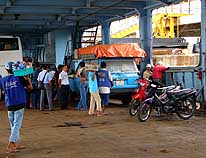
|
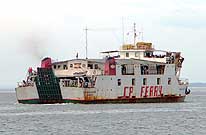
|
- Continuation:
- Pictures from the second part
- of our Indonesian trip
- in Bali from January to March 2007
|
- 49
(Bali) This rusty, not very trustful
- looking ferry brings us from Java to Bali
- – not very inspiring after the disaster of
- the Prima-Vista ferry, which drowned
- only two days ago in Indonesian waters
- off central Java’s coast causing more than
- 600 fatalities! (see picture above # 01)
|
- 50
(Bali) A similar
„pile of rust“
- tries also its luck to reach the island
- of Bali safely. If no unforeseen event
- happens, the chances are OK
|
-
|
-
- Finally, after two hours, the traffic starts rolling, but the situation is not getting
much better. We have not one single possibility to escape this madness to have a bite to
eat. Only along the Baluran Nationapark, after six hours of driving, we are able to follow
one of the vague tracks into the bushes, where we finally find “our” New Years
spot. With a glass of red wine and many cheers, we celebrate the first day of 2007. Next
morning, at 8am, we arrive at the small ferry terminal of Banyuwangi under a deep blue
sky, where we want to ferry over to neighboring Bali. The silhouette of the “Island
of the Gods” is greeting already promising across the picturesque bay. It is only one
sailing hour away and the boat that runs on an hourly schedule is ready to board. We can
hardly believe what we see when we inspect the ship closer. It is beyond every description
and imagination. What still transports passengers and cars on a daily base is merely a
piece of scrap. It is a real shock. Still too vivid is our memory of the only two days old
disastrous pictures we saw on TV from the sunken ferry of Prima Vista – the sister
ship of the vessel we sailed from Kalimantan to Java
and which took the life of 600 passengers. “Shall we take the risk, or are we playing
with our lives?” At the end – Bali being
so close – we dismiss our worries and hope for the best. But it dampens our spirit
and there is not much room left for emotions when we take off from Java. It feels good to
know though that we are not leaving Indonesia with its warmhearted and happy natured
people yet. There are many more beautiful islands waiting to be explored during the
following months.
|
-
|
| Continuation: Pictures
of the second part of our Indonesian trip
in Bali from January
2nd,
to March 25th, 2007 |
|
|
- More websites from Indonesia and
Timor-Leste:
More websites from East Malaysia and
Brunei:
|
- Articles in newspapers about us in Indonesia:
- Article: "Tamu Istimewa: Neverending
Journey", Monthly Car Magazine "Jip", January 2007
- Article: "Toyota
FJ60 1982 World Travelers", Monthly Car Magazine "Jip", February
2007
- Article: "CHEESE
LAND CRUISER", Monthly Car Magazine "BBC Top Gear", February 2007
- Article: "22
Tahun Jelajahi 156 Negara", Daily Newspaper "Post
Metro Balikpapan", July 17, 2007
|
|
























































